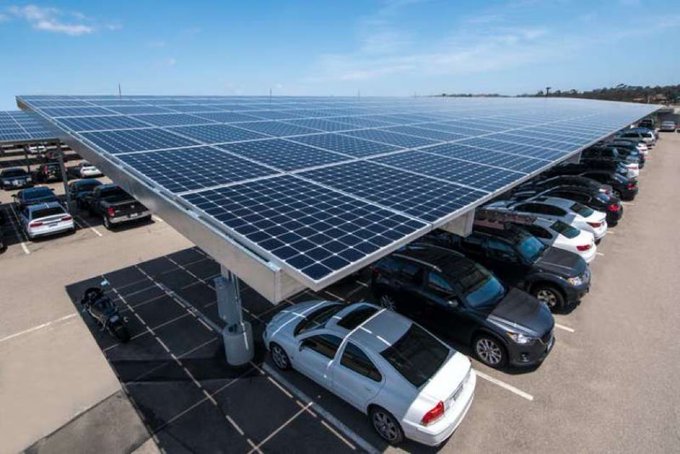
In an era where climate change concerns are escalating and urban sprawl continues to encroach on valuable farmland, an innovative solution is gaining traction: solar parking lots. This approach not only addresses the pressing need for renewable energy but also offers a smart alternative to the controversial practice of installing solar panels on agricultural land.
The debate over solar farm locations has intensified in recent years, with many communities pushing back against the use of farmland for renewable energy projects. In Ohio, for instance, at least 25 of the state’s 88 counties have placed prohibitions on solar development since 2021, according to a report from Columbia Law School’s Sabin Center. This resistance is part of a broader trend, with nearly 400 communities across the United States passing laws restricting wind and solar development as of June 2024.
The impact of these restrictions is significant. Renewable energy developers report that about one-third of their projects proposed over the last five years have been canceled due to local opposition and restrictive laws. This trend is particularly concerning given the ambitious clean energy goals set by many states and the federal government.
“I would call this the unnecessary politicization of technology that has environmental, economic and reliability benefits,” said Elise Caplan, the vice president of regulatory affairs for the American Council on Renewable Energy. The growing opposition has become a significant barrier to clean energy development, threatening the progress towards a sustainable energy future.
The controversy surrounding solar farms on agricultural land is not without merit. Current and planned solar development on farmland in the U.S. is substantial, with estimates indicating that up to 5 million acres may eventually be covered by solar panels. This represents a significant portion of the land needed to meet renewable energy goals, particularly as the nation aims for net-zero emissions by 2050.
This is not environmentalism.
— James Melville 🚜 (@JamesMelville) September 1, 2024
This is corporatism land grabbing. The vast majority of mass-scale solar panels plastered on prime farmland will end up being destroyed by bad weather, leaking toxic chemicals into the soil or eventually ending up in landfill after 25 years. pic.twitter.com/o5AXhxwbjh
The American Farmland Trust estimates that 83% of new solar installations in the coming decades will likely be on agricultural land, indicating a shift towards utilizing these areas for solar energy generation. While current usage is relatively low – only 0.3% of farmland is expected to be used for solar energy by 2035 – the trend is increasing as more projects are planned.
However, a solution may be hiding in plain sight – or more accurately, in our parking lots.
Major retailers and universities are leading the charge in transforming these vast, paved spaces into dual-purpose areas that generate clean energy while serving their primary function.
No farmland, no food: Almost 4000 acres of prime Australian agricultural land are covered over by more than a million solar panels.
— Wide Awake Media (@wideawake_media) August 8, 2024
Expect a lot more of this as a consequence of the aggressive push to achieve "net zero emissions". 🙄 pic.twitter.com/xlccOKdTyI
Retail giants Walmart and Target are leading the charge in transforming vast, paved spaces into dual-purpose areas that generate clean energy while serving their primary function. Walmart, the world’s largest retailer by revenue, has made significant strides in this area as part of its broader sustainability initiatives.
As of 2023, Walmart has installed solar canopies at seven locations in California, totaling 6.5 megawatts of capacity. This is part of the company’s ambitious goal to power 50% of its operations with renewable energy by 2025. Walmart’s commitment to sustainability extends beyond just parking lots; the company has over 600 on-site and off-site renewable energy projects in operation or under development across 14 countries, 5 continents, and 30 U.S. states.
The potential for expansion of Walmart’s solar parking lot initiative is enormous. With 3,571 U.S. Walmart supercenters, if implemented across all locations, the total capacity could reach a staggering 11.1 gigawatts. To put this in perspective, this is equivalent to the output of about a dozen large coal-fired power plants or enough to power approximately 1.1 million homes.
Walmart’s efforts in solar energy are part of a larger commitment to sustainability. The company aims to achieve zero emissions across its global operations by 2040, without relying on carbon offsets. This includes powering its facilities with 100% renewable energy by 2035. As of 2021, Walmart had already achieved 36% renewable energy globally.
Target, another major U.S. retailer, is also making significant strides in solar energy adoption, although their focus has been more on rooftop installations rather than parking lots.
As of 2022, Target had installed solar panels on 542 of its locations, generating more than 500 megawatts of energy. This makes Target the top U.S. corporate on-site solar installer, according to the Solar Energy Industries Association.
While specific data on Target’s parking lot installations is less detailed, the company has expressed interest in expanding its solar initiatives to include more parking lot canopies. In 2019, Target pledged to source 100% of its electricity from renewable sources by 2030 for its entire global operations. This goal includes all of Target’s domestic and international stores, distribution centers, and offices.
Target’s commitment to renewable energy extends beyond just solar. The company has also invested in wind energy, including the Lone Tree Wind Project in Illinois, which generates enough electricity to power 60 Target stores annually. By the end of 2020, Target had already achieved 50% renewable electricity in its operations, marking significant progress towards its 2030 goal.
Rutgers University has built one of the largest solar parking facilities in the U.S., covering 32 acres with an 8-megawatt output. This facility not only contributes to the university’s energy needs but also promotes sustainability and provides shade for parked vehicles. Michigan State University has implemented similar projects, aligning with broader sustainability goals within the university system.
The benefits of solar parking lots extend beyond energy generation. These installations can enhance the customer experience by providing shade, potentially encouraging longer shopping times. They can also support the growing electric vehicle market by incorporating charging stations, further reducing reliance on fossil fuels.
The potential for solar parking lots is particularly significant given the vast amount of land dedicated to parking in urban areas. Parking lots cover about 13,778 square miles in the U.S., which is approximately 0.47% of the total contiguous land area. This substantial area reflects the extensive infrastructure dedicated to vehicle parking, often at the expense of agricultural land.

Internationally, the trend is gaining momentum. France has taken a bold step by mandating that large parking lots (those with over 80 spaces) must cover 50% of their surface area with solar panels by 2028. This legislation is expected to add approximately 11 gigawatts of solar capacity to the national grid. Similarly, several German states, including Baden-Württemberg and North Rhine-Westphalia, have enacted laws requiring new parking lots to incorporate solar panels.
The Netherlands boasts the world’s largest parking lot solar installation in Biddinghuizen, featuring 90,000 solar panels with a capacity of 35 megawatts. These examples demonstrate the global recognition of parking lots as untapped resources for renewable energy generation.
Makro, a leading retailer in South Africa, has begun installing solar panels on the roofs of its parking lots. This initiative aims to reduce electricity costs and carbon emissions while providing shade for vehicles.
RELATED: The Hidden Costs of Renewable Energy
The global solar carport market is reflecting this growing interest, reaching approximately 482 million euros in 2022, with projections to grow to around 630 million euros by 2028. This indicates a rising interest in parking lot solar solutions worldwide.
However, challenges remain. The cost of installing solar panels in parking lots can be higher than rooftop installations, averaging around $2,780 per kilowatt compared to $1,800–2,000 for rooftop solar. Regulatory hurdles and design considerations also need to be addressed. There may be zoning laws to navigate and temporary disruptions to parking availability during construction.
Despite these challenges, the potential benefits are compelling. By utilizing existing urban infrastructure, we can generate significant amounts of clean energy without encroaching on valuable farmland. This approach aligns with the principles of sustainable urban development and addresses concerns about food security and land preservation.
The shift towards solar parking lots represents a promising opportunity to harness renewable energy without sacrificing farmland. As urban areas seek to balance development with sustainability, utilizing existing parking infrastructure for solar energy generation could play a crucial role in the energy transition.
As we navigate the complexities of the energy transition, solar parking lots offer a promising path forward. They represent a win-win solution that balances our need for renewable energy with the imperative to preserve agricultural land. By reimagining our urban spaces, we can create a more sustainable future – one parking lot at a time.
References:
Why Putting Solar Canopies on Parking Lots Is a Smart Green Move, November 22, 2021
The Overlooked Solar Power Potential of America’s Parking Lots, Time, December 8, 2022
Clean power and profit with solar parking lots, April 10, 2023
Solar Parking Lots Are a Win-Win Energy Idea. Why Aren’t They the Norm? February 13, 2023
YOU MAY ALSO LIKE: The Hidden Environmental Costs of Wind Turbines







